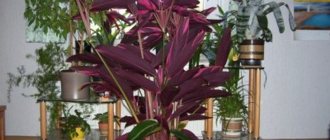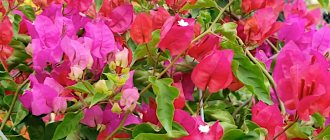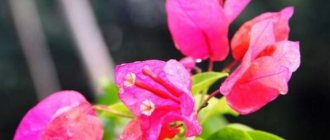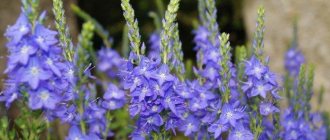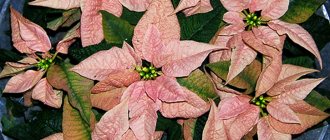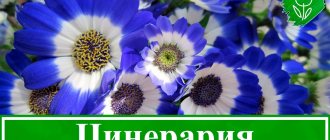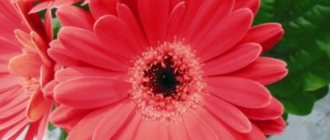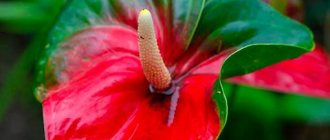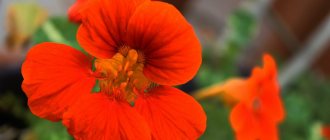lilac-pink double bracts.
'Double Orange' –
with double orange bracts; abundant flowering.
'Double Pink' –
double pink bracts with a greenish center.
'Double Red' –
with double fuchsia-raspberry bracts, the color remains the same throughout flowering; abundant flowering.
'Double Salmon' –
with double yellow-orange bracts with a pink center.
Bougainvillea spectabilis
The remarkable bougainvillea gained popularity back in the 19th century; it was found on rocky slopes in the tropical regions of Brazil.
However, in southern countries this plant was used as decoration for gazebos and greenhouses. This type of bougainvillea has large bracts and velvety leaves that turn pale when flowering.
Bougainvillea remarkable has fairly durable, pointed, heart-shaped leaves, slightly covered with hair on the back side. Remarkable bougainvillea has beautiful flowers; in this variety, at the ends of the branches they are collected in inflorescences, which open from April to mid-autumn. The flowers are up to 5 cm in length. Around the flowers there are usually up to three bracts of pink, purple or red hue. Every year the color of the stipule fades. The perianth is tube-shaped, yellow-green in color. The shoots of the plant are covered with thorns and can reach up to 9 meters.
Popular types
Of the 14 varieties of tropical creeping plant found in nature, several varieties are usually cultivated. The most commonly grown plant as a houseplant is the naked and wonderful bougainvillea. The most popular are hybrid forms, characterized by a mass of lilac-colored double bracts covering the entire foliage.
Bougainvillea is beautiful
It is a climbing vine with pubescent shoots equipped with foliage with short petioles and sharp tips. Single or collected in oblong racemes (from 3 to 5 pieces) the flowers are bordered by purple apical leaves. At home, the vine is grown as an hanging plant.
Bougainvillea smooth (naked)
Bougainvillea glabra has an even, creeping, branched stem. As a houseplant, it is cultivated as an upright bush, blooming profusely and for a long time, which can be given any desired shape by pruning. It was on its basis that most hybrids were created. The shrub has oblong shiny dark green leaves with pointed ends. It is characterized by impressive inflorescences of various light shades:
- snow-white;
- pinkish;
- lemon yellow;
- peach;
- salmon.
This type of flower is often used to breed dwarf varieties, and bonsai are successfully grown on its basis.
Bougainvillea peruviana
Bougainvillea peruviana, discovered by A. von Humboldt, is distinguished by green bark with shortened needles. This variety is not branchy, but can bloom repeatedly, especially with careful care, which includes timely pruning.
Bougainvillea is wonderful
It grows on rocky slopes in Brazil and became famous in the 19th century. In tropical countries, pavilions and greenhouses were decorated with vines reaching 15 meters in length. This variety is distinguished by large bracts and strong, velvety, heart-shaped foliage on the underside, which gradually fades. From April to October, her delightful flowers bloom, grouped in brushes up to 5 cm in size. Around each of them there are 3 light pink, lilac or reddish bracts, becoming lighter with age.
Hybrid varieties
Breeders are systematically working on the formation of new hybrid varieties, represented by all kinds of miniature forms and picturesque colors. The most widespread is the hybrid created by crossing two species: beautiful bougainvillea and Peruvian. It has fairly large oblong foliage and thorns on its shoots. The bracts of cream flowers are characterized by a rich copper-red color, changing to deep pink or purple with age.
A hybrid of bare and Peruvian varieties is also common - Bougainvillea Butte, which is distinguished by elongated dark green foliage and tiny snow-white petal corollas, surrounded by three thinnest light scarlet covering leaves.
Other varieties
Terry varieties include bougainvillea Lilarose, which is distinguished by its unpretentiousness, high decorativeness and bright long-term flowering.
An interesting variety is Don Mario with its red-burgundy apical leaf blades, delighting the owner with its picturesqueness from the beginning of spring to the end of autumn.
Bougainvillea glabra
Bougainvillea naked can grow up to 5 meters, unlike bougainvillea remarkable, so most often this plant is used as a houseplant.
It tolerates pruning painlessly, so you can shape the bush as you please. Bougainvillea glabra blooms from spring to early summer. Thanks to breeding work, the plant has a wide palette of colors.
Its stem is branched, bare, and sometimes has thorns. The leaves are bare, glossy, oval with a sharp end, up to 15 cm long, dark green. The bracts are pink, white, orange, yellow or purple. Blooms thickly and for a long time. Bougainvillea naked grows at an average pace and is quite often used for bonsai.
Indoor bougainvillea flower: catalog of varieties with photos, care and propagation at home
Bougainvillea is an evergreen plant of the nocturnal family (also known as Nyctaginaceae). The plant's homeland is South America, as well as the tropics of Brazil. The plant received its name in honor of the French traveler Louis Andoin de Bougainville.
Bougainvillea is extremely diverse: it can be either a climbing shrub, a low tree (often grown indoors as a bonsai), or a tenacious vine. It has green leaves with solid edges (sometimes they have a light border), as well as rare sharp thorns. In the wild, the plant can reach 5 meters in height, but at home, of course, such rapid growth does not occur.
In the photo of bougainvillea it is easy to notice that its flowers are rather inconspicuous and small, yellowish-white in color. The main decorative value of the plant lies not in them, but in the wide bracts of invariably bright colors . Their shades, as well as shapes, vary significantly from variety to variety. “In the wild” the plant can bloom all year round, but on apartment windowsills it is limited to 7-8 months.
The bougainvillea plant has long been considered a symbol of financial wealth. It not only attracts wealth, but also helps to manage it successfully. A favorable financial situation, prospects for a profitable investment, replenishment of the number of clients, reduction of financial risks - all this is attributed to the beneficial effects of the plant, which is why many businessmen prefer to have bougainvillea in their office.
Peruvian bougainvillea (Bougainvillea peruviana)
Bougainvillea peruviana was discovered by Alexander von Humboldt of Germany in 1810.
The leaves are long, thin, without pubescence, and have a pronounced ovoid shape. Unlike other varieties, the plant has green bark on the branches. The shoots have short and straight thorns. Bougainvillea Peruviana flowers in yellow shades. The bracts are purple or pink, round in shape, and have a leathery surface. Flowers are usually arranged singly, or in a group of up to 3 units.
This species grows quite vigorously, while being slightly bushy.
Hybrid forms of bougainvillea
Every year more and more forms of bougainvillea appear, obtained through selection.
At exhibitions this plant is presented in new decorative forms and colors.
The most common hybrid species was obtained by crossing Peruvian bougainvillea and beautiful. The resulting species has leaves that are quite large, emerald in color, and ovoid in shape. The branches have strong, straight thorns. When the bracts bloom, they are copper-red in color, and as they age, they change color to pink or purple. The flowers of this plant are in cream shades. Another, no less common hybrid species of plant was obtained by crossing bougainvillea glabra and Peruvian. The leaves are dark green and ovoid in shape. Small white flowers are located on the stems of evergreen vines. The flowers are in clusters surrounded by three thin bracts of bright pink color.
Bougainvillea species
or beautiful bougainvillea This is a vine with thorny shoots and oval pubescent leaves. The flowers are small, surrounded by 2-3 large purple or pink-red bracts that fade as they bloom. It grows quickly, the length of the shoot can reach 9 m. In warm climates it is used to decorate gazebos and create fences.
Bougainvillea naked , or smooth (Bougainvillea glabra) is found wild in relatively dry areas of Brazil and grows on rocky slopes. Its stem is bare, highly branched, in nature up to 5 m tall. It differs from other species in having less spiny and pubescent parts. The leaves are glossy, oval, dark green, 10-15 cm long. Forms with white, lemon yellow, apricot, pink, lilac, orange and red colored bracts are known. Flowering is abundant and long lasting. It grows more slowly than other species and can easily be formed into a bush.
Peruvian bougainvillea (Bougainvillea peruviana) has few branches and has long, thin, not pubescent leaves. Its flowers are yellow, the bracts are round, pink or purple, and may be slightly wrinkled. Bougainvillea peruviana can bloom several times a year if there are dry periods between flowering cycles.
These species produced many natural and artificial hybrids; on their basis, all modern varieties of beautiful bougainvillea were obtained.
Bougainvillea varieties
Today there are a large number of bougainvillea varieties that are intended for home cultivation.
They differ in color, size of bracts, shape. There are oval, triangular, double and non-double varieties of bougainvillea.
The most popular varieties:
- glabra “Sanderiana” – the plant blooms profusely and has purple bracts;
- glabra “Cypheri” – pink bracts;
- “Maud Chettleburgh” – purple-pink bracts;
- “Tomato Red” – rather large, non-double red bracts;
- “Double Red” – double, red bracts; and many others.
Next, we will consider a more detailed description of the most popular varieties of bougainvillea.
Terry varieties of bougainvillea
Terry varieties of bougainvillea have very beautiful shades of flowers.
So, for example, the variety “Double Pink” has transitions in pink colors;
“Double Lilarose” has lilac and dark pink shades; “Lateritia” has delicate shades of pink and salmon, they bloom for a long time and are easy to care for. In the “Surprise” variety, due to a bud mutation, there are branches whose bract colors differ from the branches of the mother plant. Pink bracts, at the same time, can be marbled white and pink. Propagation of such varieties can only be carried out vegetatively. Terry varieties of bougainvillea are distinguished by their rather dense caps, which are located at the ends of the shoots.
Variegated varieties of bougainvillea
Variegated varieties of bougainvillea can be obtained vegetatively through layering and cuttings.
Branches, thorns, leaves, veins - everything is green.
The colors of the bracts are quite varied; they can be either multi-colored or monochromatic. The “Raspberry Ice” variety has a cream stripe at the ends of its leaves. “San Diego Red Variegata” has golden-green leaves and red bracts. The “Delta Dawn” variety has bluish-green leaves with white edges, and golden and salmon-colored bracts. On the leaves of variegated bougainvillea varieties you can often see pink spots, not just white or gold.
Bicolor varieties
Bicolor varieties have golden or yellow branches, leaves, thorns and veins.
The color range of this variety is impressive, from stripes and spots of gold or cream to chaotic large sections of green.
These varieties of bougainvillea grow more slowly, they are whimsical, and require special attention. The bracts of bougainvillea bicolor varieties are usually in red shades. The variety “Bois De Roses” has bracts that are orange at first, but then change color and become bright pink. Similar changes in color can be seen in varieties such as “Thai Gold”: the bracts are initially golden-orange, but then change color to bright pink. Such changes can be observed in most bicolor varieties: over time, white bracts acquire red, pink or orange tones.
Bougainvillea propagation
The easiest way to propagate bougainvillea is from cuttings. It is not only reliable, but also allows you to preserve all the species and varietal characteristics of the plant.
It is best to propagate bougainvillea from cuttings in late spring - early summer. To do this, semi-lignified cuttings 8–10 centimeters long are cut from the mother plant. To speed up and facilitate rooting, the cuttings can be kept in a solution of any root formation stimulant or, immediately before planting, a cut of a bougainvillea cutting can be dipped in root powder. You can root the cuttings in the soil used for planting adult plants, slightly diluting it with peat to make it easier. Cover the top of the cutting with a glass jar and place in a warm, bright place.
Bougainvillea propagation
There are three types of plant propagation. It is necessary to understand the features of each of them.
Cuttings
This is a simple and effective method, which is the most popular among flower lovers.
Its scheme is simple:
- Preparation of planting material. Cuttings that were cut in June will be useful. The main thing is that they are semi-lignified.
- Rooting. To do this, you will need to acquire a mixture of sand and peat in advance. It is placed in a plastic cup or container with a lid and moistened. Conditions for rooting: temperature within 25-26 °C, ventilation and humidification of the greenhouse.
- Transfer. After 1.5-2 months, the cuttings will be sufficiently rooted. This will serve as a signal to replant it in a pot with the prepared composition. It includes leaf soil, peat, sand and compost. The height of the pot should not exceed 7-9 cm.
- Growing up. It is produced in a bright place at a temperature of about 20 °C.
- Pinching. There is no need to do it before the shoots grow to 5 cm. Repeated transplantation. Now you need to choose a larger pot for drainage: 11-12 cm in diameter.
- Care. Young bushes must be watered abundantly, and the root system should not be stagnant in moisture.
Reproduction by air layering
There is no time limit for such a process. It is enough to place two containers next to each other: a pot with a plant and a dish with a moistened substrate. A suitable young shoot should be found on the mother plant.
The place of its further rooting is scratched or transversely cut.
Then you need to bend the shoot to the ground from a neighboring pot. He himself will not be able to strengthen himself without fixing with a metal pin. Air layering should soon be removed from the mother plant when roots appear.
It's time to transplant them into a separate pot.
Propagation using seeds
Not every flower lover will choose this method of propagation. It requires the presence of pollinators in the form of insects. It is impossible to find hummingbirds in their native lands, because birds live in the subtropics and tropics.
If you want to start propagating using purchased seeds, you should have a lot of patience.
The time for sowing seeds is the end of February - mid-April. Initially, you need to soak them for a couple of hours in a biostimulator. The seeds are placed in a substrate of equal components of peat, leaf soil and sand. If possible, it is replaced with a finished product for flower seedlings.
In a container with a lid, the seeds are placed according to the following scheme: depth - 5 mm, distance between them - 2-3 cm. After closing the lid, the container is placed in a place with a temperature of 26 ° C with the recommendation of bottom heating. The seedlings are ventilated and sprayed with purified water.
It is necessary to take care of lighting in advance, which becomes problematic in winter. The problem will be solved by using a phytolamp or a fluorescent lamp.
The container lid is opened 2-3 months after germination. Next, the future shrub is grown in a pot with soil and drainage.
Indoor bougainvillea (Bougainvillea) and bougainvillea for the garden: varieties in the photo
A famous and popular plant due to its long flowering period, it is a South American plant of the Nyctoginaceae family, widely distributed in tropical and subtropical regions of the country. Bougainvillea flower has 14 species in its genus and in its homeland, under natural conditions it can bloom all year round.
- Homeland: South America.
- Family: Nygoginaceae.
- Illumination: bright light.
- Watering: abundant in summer, moderate in winter.
- Keeping temperature: summer +20 +25 ° C, winter 12 +14 ° C.
Description: It is a creeping shrub, a small tree or a clinging vine with sparse sharp thorns and alternate, entire green leaves. The flowers are small, yellow-white, surrounded by 3 bracts up to 6 cm long. They come in a variety of colors in different varieties: orange, red, violet, pink, peach, purple, cream and white. Very often there are 2-colored or changing color during the flowering period of bougainvillea. Bracts can be of various shapes: triangular, round, heart-shaped, and the edges are oblong, wavy or finger-shaped.
Thanks to its young flexible and long shoots that become lignified over time, the plant lends itself perfectly to molding and, depending on the need, it can be grown as a bush, liana or standard tree.
Bougainvillea
Bougainvillea belongs to a genus of tropical evergreen shrubs belonging to the Nociformes (Niktaginaceae) family.
Their homeland is Brazil. The plant, named after the French traveler L.A. de Bougainville, who led the first French expedition around the world, is a bush, tree or vine, distinguished by elongated, plastic, prickly branches. Bougainvillea has won recognition from plant growers for its luxurious, long-lasting flowering, which continues year-round in the tropics. In our area, it can decorate any room, although its cultivation is considered quite difficult.
Bougainvillea indoors
In indoor conditions, the plant should be placed in a well-lit place with moderate temperature, without exposure to direct sunlight. Indoor bougainvillea, with proper care, blooms profusely for 7-8 months, in autumn, winter and spring, starting in November with purple or pink flowers up to 2.5 cm in diameter. Ideal keeping conditions are temperature in the summer within +20 +25 °C, in winter +12 +16 °C.
From spring to autumn, it is recommended to place it in the fresh air in the garden or on an open balcony, protected from precipitation and drafts, and in the first 2 weeks in a shaded place until it gets used to bright light.
Replanting and pruning Bougainvillea
When caring indoors, it is important to properly replant and prune the plant.
The best time for replanting is considered to be the beginning of spring growth. You should not replant the flower into a large pot. The smaller the pot, the more abundant the flowering will be. A young bush must be replanted annually, and adults - once every 3-4 years.
To prevent the flower from getting sick after transplantation, it is recommended to transfer it to a new pot and add the missing soil. To make the flower more colorful, you can plant two bushes with different colored stipules in one pot.
They give the bush the desired shape using pruning, which also enhances flowering. Several prunings are carried out throughout the year, cutting off dried stems and unattractive inflorescences.
Over the course of one year, several prunings are carried out. Fading bracts are cut back to a third of their length. Trim only young shoots. Repeat pruning in the fall until dormancy begins. The shoots in the form of vines left on the bush look impressive.
An ancient Indian legend about the beautiful Bougainvillea tells that once upon a time she was a charming girl whose beauty was envied by an evil witch. Envy overwhelmed her, and she turned the girl into a vine with inconspicuous small flowers. The gods took pity on the innocent victim and allowed her to endlessly “bloom” with leaves. This is how a flower of charming beauty appeared.
Bougainvillea - plant varieties
The most commonly grown species are naked bougainvillea (Bougainvillea glabra) and wonderful bougainvillea (Bougaivillea spectabilis), as well as their numerous hybrid varieties, which differ from each other in color and size of bracts. Bougainvillea has varieties for home cultivation:
Bau De Roses - with very large bracts that are orange at the beginning of the flowering period and bright pink at the end.
Donyo – retains a soft pink color throughout the entire flowering period.
California Gold - bright yellow at the beginning of flowering, and becomes noticeably lighter towards the end.
Double Beauty (Double Red) – bracts of medium size, double, fuchsia-crimson in color throughout the entire flowering period. Blooms profusely.
Jamaica White - very large white bracts throughout flowering.
Glabra - with lilac-violet bracts.
Compact - red brick color at the beginning and bright crimson at the end. Very large bracts. Abundant flowering.
Singapore Pink - with pinkish-lilac, elongated bracts.
Thai Gold is a very beautiful, profusely flowering variety with terry-fluffy bracts of bright orange color at the beginning of flowering, which gradually become soft pink.
Vera Deep Purple is one of the most common varieties with bright fuchsia-raspberry, large bracts and abundant flowering.
Bougainvillea photo gallery
- Whitefly - pest control in the garden
- Onion fly - how to fight it
- Lobelia - planting and care
- Sedum - planting and care
- We decorate the flowerbed with decorative onions “Allium”
- Phytophthora of tomatoes: signs and methods of control
- Do-it-yourself swing for a summer house
- Mixture for saving yellowing cucumbers
- How to get rid of ants - all methods of control
- DIY country veranda
- Fixing covering material on the bed
- Early spring flowers in the garden
Bougainvillea growing in the garden
The plant is tropical and heat-loving; it dies at sub-zero temperatures. Growing bougainvillea in the garden in open ground is possible only in the southern regions, where the air temperature does not fall below +5°C. In this case, it is necessary to constantly shape the crown, since the plant will not branch well without pruning and will not grow developed.
Bougainvillea is most often used as a large tub plant placed in a greenhouse or winter garden.
Bougainvillea: flower description
In its natural environment, the Bougainvillea flower is most often found in South America. In nature, the plant develops in the form of a shrub or small tree, up to 5 meters high. Thanks to the warm climate, close to the subtropics, the plant does not have dormant periods; all year round, lush, spreading bushes look very bright and impressive. In its homeland, Bougainvillea grows everywhere. The bush can be seen among the rocks, along the routes. And in cities it easily climbs the steep walls of various buildings.
It is not the flowers that make the plant attractive; they are so small that they are practically invisible. It's all about the numerous bracts, which have a bright, rich color.
The climatic conditions of most regions of Russia do not allow growing Bougainvillea in open ground, since the plant dies already at an air temperature of -5 degrees. The exception is some regions of the Caucasus, whose climate is closest to subtropical. Therefore, for us, Bougainvillea is exclusively an indoor plant. Also, shrubs are often grown in greenhouses and, of course, botanical gardens. In indoor conditions, the plant experienced a lack of light, as a result, over time, indoor Bougainvillea stopped blooming all year round. However, when creating conditions close to the plant's natural growing environment, the Bougainvillea flower will bloom up to several times throughout the year.
By the way, Bougainvillea is not one plant, but a whole genus. The genus received its name in honor of Louis Antoine de Bougainville, who led the first French expedition around the world.
Bougainvillea plant: photo of an indoor flower
Bougainvillea - plant care
The plant needs nutritious, fertile soil with low acidity. A substrate made of leaf, humus, peat, turf soil and coarse river sand in equal proportions is suitable. Be sure to have good drainage. In soil where there is little calcium, it is recommended to add lime 1-1.5% of the volume.
Replanting for young plants (up to 3 years old) is carried out in the spring once every 2-3 years, and for adult specimens once every 4-5 years. When replanting, you must not destroy the earthen ball with the root system - damage to the roots, especially in adult plants, leads to disease, loss of leaves and bracts.
In summer it needs abundant watering with warm, settled water, preferably in the morning. In winter - as the substrate dries out.
Bougainvillea requires care - regular application of fertilizers for flowering plants once a week from March to October. During the flowering period, it is recommended to feed large tub plants with complex mineral fertilizer 2 times a week.
Bougainvillea is propagated by cuttings throughout the year, and by mature cuttings in spring and summer.
Bougainvillea is a hardy crop that is rarely attacked by pests, but spider mites, aphids and mealybugs may occasionally infest it. It is necessary to do a preventive examination 2-3 times a week, especially during flowering. If parasites are present, alcohol treatment or treatment with a water-oil emulsion will help. In case of severe infection, treat with the Aktara insecticide, a solution of 4 g per 5 liters of water.
Mr. Summer Resident warns: possible problems when growing bougainvillea
Incorrect care of shrubs often leads to complications during cultivation, for example, various diseases and pest attacks.
- When mold becomes infected, white spots appear on the leaves. The reason is excess humidity and insufficient ventilation. You can save the flower by moving it to a well-ventilated room.
- Aphids, which are visible on the underside of the foliage, are fraught with depigmentation, curling and falling of leaves. Treatment consists of using a soap solution and treating with an insecticide.
- Mealybugs damage flowers and buds, inhibiting the development of the bush. It is recommended to treat with a soap solution or alcohol, then cut off the parts of the plant affected by the pest.
- To resuscitate a vine when the root system is damaged, it is removed from the pot and the roots are disinfected, while cutting off the injured areas and sprinkling them with wood ash. Inadvertently broken branches must be pruned so that new shoots can grow from the bush later. Removed stems can be used to root new flowers.
Thanks to its decorative value, bougainvillea has won the recognition of many flower growers, who are not stopped by some difficulties in its cultivation and care. A luxurious tropical plant native to Brazil decorates greenhouses with long, abundant flowering and successfully decorates southern window sills of apartments. It can be given any shape if desired.
Bougainvillea Alexandra
Decorative flowering shrub up to 50 cm tall with climbing, sparsely thorny shoots. Bougainvillea Alexandra has large purple-violet bracts. The flowers are small, located on the tops of the shoots, surrounded by bright green leaves. During the flowering period, Alexandra is completely covered with elegant bright lilac, violet, pink, orange and red bracts.
If you want to buy bougainvillea in a pot
It is better to buy bougainvillea (like any indoor flowers) in stores rather than in markets—indoors create more favorable conditions for flowers. Take your time and carefully inspect the plant: there should be no spots on the leaves and bracts, wet rotting areas, dry tips and, of course, no insect pests. The plant should not be drooping or withering. A strong flower will better withstand a change of environment.
Immediately choose a permanent place for bougainvillea: this plant has a very negative attitude towards change and rearrangement. For this reason, immediately after purchase, it can shed a significant amount of foliage and flowers. There is no need to worry - soon the plant will get used to the new place and quickly recover.
LiveInternetLiveInternet
-Music
–Tags
–Categories
- parables (13)
- art (2)
- architecture (304)
- audio books (182)
- virtual travel (34)
- knitting (1273)
- accessories (82)
- magazines. collections. (345)
- Ireland (114)
- models (392)
- fillet (34)
- knitting school (393)
- cities and countries (1181)
- Australia (7)
- Austria (27)
- England (102)
- Benelux (28)
- Brazil (2)
- Hungary (6)
- Germany (83)
- Greece (10)
- other (60)
- Egypt (3)
- Ireland (13)
- Spain (37)
- Italy (83)
- China (17)
- Mexico (5)
- Norway (23)
- Poland (12)
- Portugal (11)
- Russia (181)
- Union (93)
- USA (25)
- Türkiye (12)
- Finland (10)
- France (104)
- Czech Republic (23)
- Switzerland (25)
- Sweden (11)
- Scotland (17)
- Emirates (3)
- Japan (26)
- cottage (258)
- children (56)
- painting (654)
- riddles (40)
- locks (140)
- celebrities (106)
- games, flash drives (49)
- interior (142)
- history (183)
- books (176)
- computer, Li.ru (157)
- beauties of the past (144)
- fashion, fashion history (116)
- beauty and health (320)
- cosmetics (22)
- medicinal (149)
- masks (100)
- cooking (690)
- pancakes, pancakes (14)
- baked goods (153)
- dessert (69)
- blanks (15)
- microwave (16)
- meat (86)
- drinks (20)
- vegetables (87)
- cookies (19)
- fish (41)
- salads (48)
- sauces (11)
- soups (15)
- cakes (51)
- wise thoughts (76)
- museums (36)
- music (175)
- usefulness (107)
- holidays (61)
- nature (1427)
- butterflies (70)
- stones (4)
- seasons (147)
- mountains (183)
- animals (169)
- forest (66)
- macro (77)
- insects (83)
- sky (71)
- ocean (116)
- islands (63)
- birds (159)
- plants (156)
- rivers, lakes, waterfalls (211)
- element (64)
- colors of life (19)
- flowers (367)
- miscellaneous (259)
- handicrafts (464)
- batik, felting, weaving (11)
- bottles (37)
- ribbon embroidery (9)
- decoupage (9)
- dolls, toys (26)
- furniture (21)
- shoes (6)
- newspaper weaving (13)
- patchwork (7)
- shells, pebbles (19)
- candles and candlesticks (13)
- bags (37)
- decorations (21)
- cold porcelain, plastic (28)
- sculpture (216)
- poems (242)
- street art (43)
- movies (137)
- documentary (31)
- photo (109)
- photo lessons (66)
- humor (514)
